Simulating Hydrological Impacts under Climate Change: Implications from Methodological Differences of a Pan European Assessment
Abstract
:1. Introduction
2. Materials and Methods
2.1. Climate Model Ensembles
2.1.1. ISIMIP
2.1.2. Euro-CORDEX
2.1.3. HELIX AGCMs
2.2. Hydrological Modeling
2.3. Global Warming Levels and Model Agreement
2.4. Hydrologic Indicators and Characterization of Drought
- Mean runoff (RF mean): The long-term average of runoff is a basic indicator for mean water availability.
- 10th percentile runoff (RF low): The lower 10th percentile of runoff distribution serves as an indicator for low flows.
- 95th percentile runoff (RF high): The 95th percentile of runoff distribution serves as an indicator for high flows.
3. Results
3.1. General Comparison between Ensembles: ISIMIP vs. Euro-CORDEX vs. HELIX AGCMs
3.2. The Effect of the High-Resolution AGCM
3.3. The Response of Atmosphere Models on the Drier (r1) and Wetter (r3) Forcing
3.4. A combined Ensemble, Consisting of the Three Subsets (for SRI)
4. Discussion and Conclusions
- the differences and similarities between the projections of the three ensembles and assessed the possible added value provided by the newer HELIX AGCMs simulations.
- the effect of the HELIX AGCM on the projections as simulated by the JULES LSM.
- the impact of the +4GWL compared to the +2GWL and +1.5GWL.
Author Contributions
Funding
Acknowledgments
Conflicts of Interest
References
- Lutz, A.F.; Ter Maat, H.W.; Biemans, H.; Shrestha, A.B.; Wester, P.; Immerzeel, W.W. Selecting representative climate models for climate change impact studies: An advanced envelope-based selection approach. Int. J. Climatol. 2016, 36, 3988–4005. [Google Scholar] [CrossRef]
- Mendlik, T.; Gobiet, A. Selecting climate simulations for impact studies based on multivariate patterns of climate change. Clim. Chang. 2016, 135, 381–393. [Google Scholar] [CrossRef] [PubMed]
- McSweeney, C.F.; Jones, R.G.; Lee, R.W.; Rowell, D.P. Selecting CMIP5 GCMs for downscaling over multiple regions. Clim. Dyn. 2015, 44, 3237–3260. [Google Scholar] [CrossRef]
- Sun, Q.; Miao, C.; Duan, Q. Comparative analysis of CMIP3 and CMIP5 global climate models for simulating the daily mean, maximum, and minimum temperatures and daily precipitation over China. J. Geophys. Res. Atmos. 2015, 120. [Google Scholar] [CrossRef]
- Nikulin, G.; Asharaf, S.; Magariño, M.E.; Calmanti, S.; Cardoso, R.M.; Bhend, J.; Fernández, J.; Frías, M.D.; Fröhlich, K.; Früh, B.; et al. Dynamical and statistical downscaling of a global seasonal hindcast in eastern Africa. Clim. Serv. 2017. [Google Scholar] [CrossRef]
- Ramarohetra, J.; Pohl, B.; Sultan, B. Errors and uncertainties introduced by a regional climate model in climate impact assessments: Example of crop yield simulations in West Africa. Environ. Res. Lett. 2015, 10, 124014. [Google Scholar] [CrossRef] [Green Version]
- Grillakis, M.G.; Koutroulis, A.G.; Daliakopoulos, I.N.; Tsanis, I.K. A method to preserve trends in quantile mapping bias correction of climate modeled temperature. Earth Syst. Dyn. 2017, 8, 889–900. [Google Scholar] [CrossRef] [Green Version]
- Papadimitriou, L.V.; Koutroulis, A.G.; Grillakis, M.G.; Tsanis, I.K. The effect of GCM biases on global runoff simulations of a land surface model. Hydrol. Earth Syst. Sci. 2017, 21, 4379–4401. [Google Scholar] [CrossRef] [Green Version]
- Hagemann, S.; Chen, C.; Haerter, J.O.; Heinke, J.; Gerten, D.; Piani, C. Impact of a Statistical Bias Correction on the Projected Hydrological Changes Obtained from Three GCMs and Two Hydrology Models. J. Hydrometeorol. 2011, 12, 556–578. [Google Scholar] [CrossRef]
- Koutroulis, A.G.; Grillakis, M.G.; Daliakopoulos, I.N.; Tsanis, I.K.; Jacob, D. Cross sectoral impacts on water availability at +2 °C and +3 °C for east Mediterranean island states: The case of Crete. J. Hydrol. 2016, 532. [Google Scholar] [CrossRef]
- Koutroulis, A.G.; Tsanis, I.K.; Daliakopoulos, I.N.; Jacob, D. Impact of climate change on water resources status: A case study for Crete Island, Greece. J. Hydrol. 2013, 479, 146–158. [Google Scholar] [CrossRef] [Green Version]
- Madsen, M.S.; Langen, P.L.; Boberg, F.; Christensen, J.H. Inflated Uncertainty in Multimodel-Based Regional Climate Projections. Geophys. Res. Lett. 2017, 44, 11606–11613. [Google Scholar] [CrossRef] [PubMed]
- Graham, L.P.; Hagemann, S.; Jaun, S.; Beniston, M. On interpreting hydrological change from regional climate models. Clim. Chang. 2007, 81, 97–122. [Google Scholar] [CrossRef] [Green Version]
- Karlsson, I.B.; Sonnenborg, T.O.; Refsgaard, J.C.; Trolle, D.; Børgesen, C.D.; Olesen, J.E.; Jeppesen, E.; Jensen, K.H. Combined effects of climate models, hydrological model structures and land use scenarios on hydrological impacts of climate change. J. Hydrol. 2016, 535, 301–317. [Google Scholar] [CrossRef]
- Grillakis, M.G.; Koutroulis, A.G.; Tsanis, I.K. Climate change impact on the hydrology of Spencer Creek watershed in Southern Ontario, Canada. J. Hydrol. 2011, 409. [Google Scholar] [CrossRef]
- Fang, G.; Yang, J.; Chen, Y.; Li, Z.; De Maeyer, P. Impact of GCM structure uncertainty on hydrological processes in an arid area of China. Hydrol. Res. 2017. [Google Scholar] [CrossRef]
- Mendoza, P.A.; Clark, M.P.; Mizukami, N.; Gutmann, E.D.; Arnold, J.R.; Brekke, L.D.; Rajagopalan, B. How do hydrologic modeling decisions affect the portrayal of climate change impacts? Hydrol. Process. 2016, 30, 1071–1095. [Google Scholar] [CrossRef]
- Taylor, K.E.; Stouffer, R.J.; Meehl, G.A. An Overview of CMIP5 and the Experiment Design. Bull. Am. Meteorol. Soc. 2012, 93, 485–498. [Google Scholar] [CrossRef] [Green Version]
- McSweeney, C.F.; Jones, R.G. How representative is the spread of climate projections from the 5 CMIP5 GCMs used in ISI-MIP? Clim. Serv. 2016, 1, 24–29. [Google Scholar] [CrossRef]
- Warszawski, L.; Frieler, K.; Huber, V.; Piontek, F.; Serdeczny, O.; Schewe, J. The Inter-Sectoral Impact Model Intercomparison Project (ISI-MIP): Project framework. Proc. Natl. Acad. Sci. USA 2014, 111, 3228–3232. [Google Scholar] [CrossRef] [PubMed]
- Prudhomme, C.; Giuntoli, I.; Robinson, E.L.; Clark, D.B.; Arnell, N.W.; Dankers, R.; Fekete, B.M.; Franssen, W.; Gerten, D.; Gosling, S.N.; et al. Hydrological droughts in the 21st century, hotspots and uncertainties from a global multimodel ensemble experiment. Proc. Natl. Acad. Sci. USA 2014, 111, 3262–3267. [Google Scholar] [CrossRef] [PubMed] [Green Version]
- Van Vliet, M.T.H.; Donnelly, C.; Strömbäck, L.; Capell, R.; Ludwig, F. European scale climate information services for water use sectors. J. Hydrol. 2015, 528, 503–513. [Google Scholar] [CrossRef]
- Rummukainen, M. Added value in regional climate modeling. Wiley Interdiscip. Rev. Clim. Chang. 2016, 7, 145–159. [Google Scholar] [CrossRef]
- Jacob, D.; Petersen, J.; Eggert, B.; Alias, A.; Christensen, O.B.; Bouwer, L.M.; Braun, A.; Colette, A.; Déqué, M.; Georgievski, G.; et al. EURO-CORDEX: New high-resolution climate change projections for European impact research. Reg. Environ. Chang. 2014, 14, 563–578. [Google Scholar] [CrossRef]
- Caron, L.-P.; Jones, C.G.; Winger, K. Impact of resolution and downscaling technique in simulating recent Atlantic tropical cylone activity. Clim. Dyn. 2011, 37, 869–892. [Google Scholar] [CrossRef]
- Manganello, J.V.; Hodges, K.I.; Kinter, J.L.; Cash, B.A.; Marx, L.; Jung, T.; Achuthavarier, D.; Adams, J.M.; Altshuler, E.L.; Huang, B.; et al. Tropical Cyclone Climatology in a 10-km Global Atmospheric GCM: Toward Weather-Resolving Climate Modeling. J. Clim. 2012, 25, 3867–3893. [Google Scholar] [CrossRef]
- Koutroulis, A.G.; Grillakis, M.G.; Tsanis, I.K.; Papadimitriou, L. Evaluation of precipitation and temperature simulation performance of the CMIP3 and CMIP5 historical experiments. Clim. Dyn. 2016, 47. [Google Scholar] [CrossRef]
- de Souza Custodio, M.; da Rocha, R.P.; Ambrizzi, T.; Vidale, P.L.; Demory, M.-E. Impact of increased horizontal resolution in coupled and atmosphere-only models of the HadGEM1 family upon the climate patterns of South America. Clim. Dyn. 2017, 48, 3341–3364. [Google Scholar] [CrossRef]
- Zhang, L.; Wu, P.; Zhou, T.; Roberts, M.J.; Schiemann, R. Added value of high resolution models in simulating global precipitation characteristics. Atmos. Sci. Lett. 2016, 17, 646–657. [Google Scholar] [CrossRef] [Green Version]
- Hewitt, H.T.; Copsey, D.; Culverwell, I.D.; Harris, C.M.; Hill, R.S.R.; Keen, A.B.; McLaren, A.J.; Hunke, E.C. Design and implementation of the infrastructure of HadGEM3: The next-generation Met Office climate modelling system. Geosci. Model Dev. 2011, 4, 223–253. [Google Scholar] [CrossRef]
- Vautard, R.; Christidis, N.; Ciavarella, A.; Alvarez-Castro, C.; Bellprat, O.; Christiansen, B.; Colfescu, I.; Cowan, T.; Doblas-Reyes, F.; Eden, J.; et al. Evaluation of the HadGEM3-A simulations in view of detection and attribution of human influence on extreme events in Europe. Clim. Dyn. 2018, 1–24. [Google Scholar] [CrossRef] [Green Version]
- Hazeleger, W.; Wang, X.; Severijns, C.; Ştefănescu, S.; Bintanja, R.; Sterl, A.; Wyser, K.; Semmler, T.; Yang, S.; van den Hurk, B.; et al. EC-Earth V2.2: Description and validation of a new seamless earth system prediction model. Clim. Dyn. 2011, 39, 2611–2629. [Google Scholar] [CrossRef]
- Hempel, S.; Frieler, K.; Warszawski, L.; Schewe, J.; Piontek, F. A trend-preserving bias correction—The ISI-MIP approach. Earth Syst. Dyn. 2013, 4, 219–236. [Google Scholar] [CrossRef]
- Weedon, G.P.; Gomes, S.; Viterbo, P.; Österle, H.; Adam, J.C.; Bellouin, N.; Boucher, O.; Best, M. The WATCH Forcing Data 1958–2001: A Meteorological Forcing Dataset for Land Surface and Hydrological Models; WATCH Technical Report No. 22; European Commission: Brussels, Belgium, 2010. [Google Scholar]
- Samuelsson, P.; Jones, C.G.; Will’En, U.; Ullerstig, A.; Gollvik, S.; Hansson, U.; Jansson, E.; KjellstroM, C.; Nikulin, G.; Wyser, K. The Rossby Centre Regional Climate model RCA3: Model description and performance. Tellus A Dyn. Meteorol. Oceanogr. 2011, 63, 4–23. [Google Scholar] [CrossRef]
- Grillakis, M.G.; Koutroulis, A.G.; Tsanis, I.K. Multisegment statistical bias correction of daily GCM precipitation output. J. Geophys. Res. Atmos. 2013, 118, 3150–3162. [Google Scholar] [CrossRef] [Green Version]
- Haylock, M.R.; Hofstra, N.; Klein Tank, A.M.G.; Klok, E.J.; Jones, P.D.; New, M. A European daily high-resolution gridded data set of surface temperature and precipitation for 1950–2006. J. Geophys. Res. 2008, 113, D20119. [Google Scholar] [CrossRef]
- Wyser, K.; Strandberg, G.; Caesar, J.; Gohar, L. Documentation of Changes in Climate Variability and Extremes Simulated by the HELIX AGCMs at the 3 SWLs and Comparison in Equivalent SST/SIC Low-Resolution CMIP5; HELIX Project Deliverable 3.1. Projections; European Commission: Brussels, Belgium, 2016. [Google Scholar]
- Alfieri, L.; Bisselink, B.; Dottori, F.; Naumann, G.; de Roo, A.; Salamon, P.; Wyser, K.; Feyen, L. Global projections of river flood risk in a warmer world. Earth Futur. 2017, 5, 171–182. [Google Scholar] [CrossRef] [Green Version]
- Shannon, S.; Smith, R.; Wiltshire, A.; Payne, T.; Huss, M.; Betts, R.; Caesar, J.; Koutroulis, A.; Jones, D.; Harrison, S. Global glacier volume projections under high-end climate change scenarios. Cryosph. Discuss. 2018. [Google Scholar] [CrossRef]
- Sheffield, J.; Goteti, G.; Wood, E.F. Development of a 50-Year High-Resolution Global Dataset of Meteorological Forcings for Land Surface Modeling. J. Clim. 2006, 19, 3088–3111. [Google Scholar] [CrossRef]
- Best, M.J.; Pryor, M.; Clark, D.B.; Rooney, G.G.; Essery, R.L.H.; Ménard, C.B.; Edwards, J.M.; Hendry, M.A.; Porson, A.; Gedney, N.; et al. The Joint UK Land Environment Simulator (JULES), model description—Part 1: Energy and water fluxes. Geosci. Model Dev. 2011, 4, 677–699. [Google Scholar] [CrossRef]
- Clark, D.B.; Mercado, L.M.; Sitch, S.; Jones, C.D.; Gedney, N.; Best, M.J.; Pryor, M.; Rooney, G.G.; Essery, R.L.H.; Blyth, E.; et al. The Joint UK Land Environment Simulator (JULES), model description—Part 2: Carbon fluxes and vegetation dynamics. Geosci. Model Dev. 2011, 4, 701–722. [Google Scholar] [CrossRef] [Green Version]
- Davie, J.C.S.; Falloon, P.D.; Kahana, R.; Dankers, R.; Betts, R.; Portmann, F.T.; Wisser, D.; Clark, D.B.; Ito, A.; Masaki, Y.; et al. Comparing projections of future changes in runoff from hydrological and biome models in ISI-MIP. Earth Syst. Dyn. 2013, 4, 359–374. [Google Scholar] [CrossRef] [Green Version]
- Falloon, P.; Jones, C.D.; Ades, M.; Paul, K. Direct soil moisture controls of future global soil carbon changes: An important source of uncertainty. Glob. Biogeochem. Cycles 2011, 25. [Google Scholar] [CrossRef] [Green Version]
- Papadimitriou, L.V.; Koutroulis, A.G.; Grillakis, M.G.; Tsanis, I.K. High-end climate change impact on European water availability and stress: Exploring the presence of biases. Hydrol. Earth Syst. Sci. Discuss. 2015, 12, 7267–7325. [Google Scholar] [CrossRef]
- Koutroulis, A.G.; Papadimitriou, L.V.; Grillakis, M.G.; Tsanis, I.K.; Wyser, K.; Betts, R.A. Freshwater vulnerability under high end climate change. A pan-European assessment. Sci. Total Environ. 2018, 613–614, 271–286. [Google Scholar] [CrossRef] [PubMed]
- Betts, R.A.; Alfieri, L.; Bradshaw, C.; Caesar, J.; Feyen, L.; Friedlingstein, P.; Gohar, L.; Koutroulis, A.; Lewis, K.; Morfopoulos, C.; et al. Changes in climate extremes, fresh water availability and vulnerability to food insecurity projected at 1.5 °C and 2 °C global warming with a higher-resolution global climate model. Philos. Trans. R. Soc. A Math. Phys. Eng. Sci. 2018, 376. [Google Scholar] [CrossRef] [PubMed]
- Jacob, D.; Kotova, L.; Teichmann, C.; Sobolowski, S.P.; Vautard, R.; Donnelly, C.; Koutroulis, A.G.; Grillakis, M.G.; Tsanis, I.K.; Damm, A.; et al. Climate Impacts in Europe Under +1.5 °C Global Warming. Earth Futur. 2018. [Google Scholar] [CrossRef]
- Donnelly, C.; Greuell, W.; Andersson, J.; Gerten, D.; Pisacane, G.; Roudier, P.; Ludwig, F. Impacts of climate change on European hydrology at 1.5, 2 and 3 degrees mean global warming above preindustrial level. Clim. Chang. 2017. [Google Scholar] [CrossRef]
- Shukla, S.; Wood, A.W. Use of a standardized runoff index for characterizing hydrologic drought. Geophys. Res. Lett. 2008, 35, L02405. [Google Scholar] [CrossRef]
- Mckee, T.B.; Doesken, N.J.; Kleist, J. The relationship of drought frequency and duration to time scales. In Proceedings of the 8th Conference on Applied Climatology, Anaheim, CA, USA, 17–22 January 1993. [Google Scholar]
- Dubrovsky, M.; Svoboda, M.D.; Trnka, M.; Hayes, M.J.; Wilhite, D.A.; Zalud, Z.; Hlavinka, P. Application of relative drought indices in assessing climate-change impacts on drought conditions in Czechia. Theor. Appl. Climatol. 2009, 96, 155–171. [Google Scholar] [CrossRef]
- Christensen, H.J.; Christensen, B.O. A summary of the PRUDENCE model projections of changes in European climate by the end of this century. Clim. Res. 2007, 81, 7–30. [Google Scholar] [CrossRef]
- Cattiaux, J.; Douville, H.; Peings, Y. European temperatures in CMIP5: Origins of present-day biases and future uncertainties. Clim. Dyn. 2013, 41, 2889–2907. [Google Scholar] [CrossRef]
- Wada, Y.; Flörke, M.; Hanasaki, N.; Eisner, S.; Fischer, G.; Tramberend, S.; Satoh, Y.; van Vliet, M.T.H.; Yillia, P.; Ringler, C.; et al. Modeling global water use for the 21st century: The Water Futures and Solutions (WFaS) initiative and its approaches. Geosci. Model Dev. 2016, 9, 175–222. [Google Scholar] [CrossRef]
- Demory, M.-E.; Vidale, P.L.; Roberts, M.J.; Berrisford, P.; Strachan, J.; Schiemann, R.; Mizielinski, M.S. The role of horizontal resolution in simulating drivers of the global hydrological cycle. Clim. Dyn. 2014, 42, 2201–2225. [Google Scholar] [CrossRef]
- Huang, D.; Yan, P.; Zhu, J.; Zhang, Y.; Kuang, X.; Cheng, J. Uncertainty of global summer precipitation in the CMIP5 models: A comparison between high-resolution and low-resolution models. Theor. Appl. Climatol. 2018, 132, 55–69. [Google Scholar] [CrossRef]
- Gudmundsson, L.; Wagener, T.; Tallaksen, L.M.; Engeland, K. Evaluation of nine large-scale hydrological models with respect to the seasonal runoff climatology in Europe. Water Resour. Res. 2012, 48. [Google Scholar] [CrossRef] [Green Version]
- Hagemann, S.; Chen, C.; Clark, D.B.; Folwell, S.; Gosling, S.N.; Haddeland, I.; Hanasaki, N.; Heinke, J.; Ludwig, F.; Voss, F.; et al. Climate change impact on available water resources obtained using multiple global climate and hydrology models. Earth Syst. Dyn. 2013, 4, 129–144. [Google Scholar] [CrossRef]
- Haddeland, I.; Clark, D.B.; Franssen, W.; Ludwig, F.; Voß, F.; Arnell, N.W.; Bertrand, N.; Best, M.; Folwell, S.; Gerten, D.; et al. Multimodel Estimate of the Global Terrestrial Water Balance: Setup and First Results. J. Hydrometeorol. 2011, 12, 869–884. [Google Scholar] [CrossRef] [Green Version]
- Giuntoli, I.; Vidal, J.; Prudhomme, C.; Hannah, D.M. Future hydrological extremes: The uncertainty from multiple global climate and global hydrological models. Earth Syst. Dyn. 2015, 1–30. [Google Scholar] [CrossRef]
- Lenton, T.M.; Ciscar, J.-C. Integrating tipping points into climate impact assessments. Clim. Chang. 2012, 585–597. [Google Scholar] [CrossRef]
- Rosenzweig, C.; Arnell, N.W.; Ebi, K.L.; Otze-Campen, H.; Raes, F.; Rapley, C.; Stafford Smith, M.; Cramer, W.; Frieler, K.; Reyer, C.P.O.; et al. Assessing inter-sectoral climate change risks: The role of ISIMIP Assessing inter-sectoral climate change risks: The role of ISIMIP. Environ. Res. Lett. 2017, 12. [Google Scholar] [CrossRef]

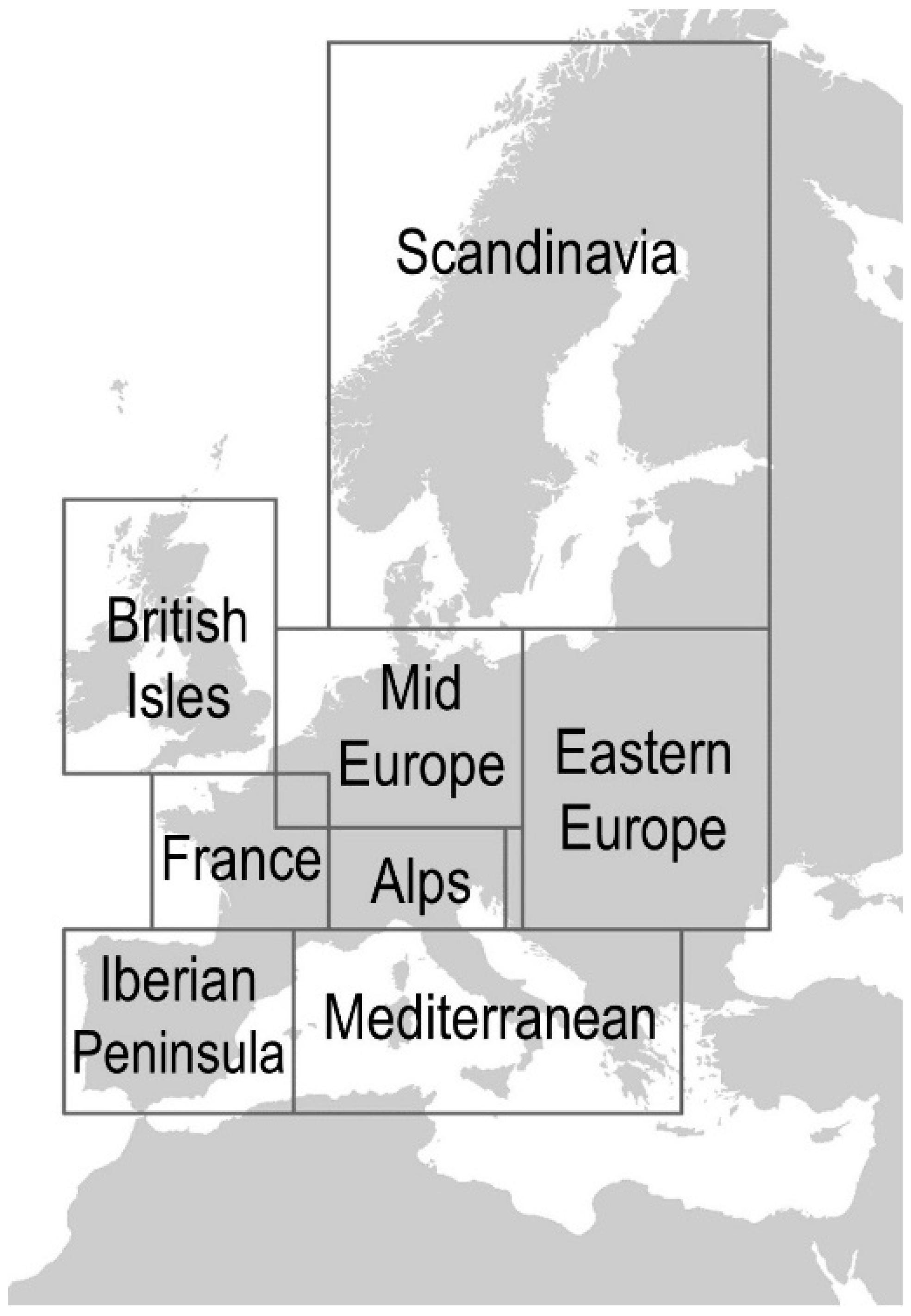
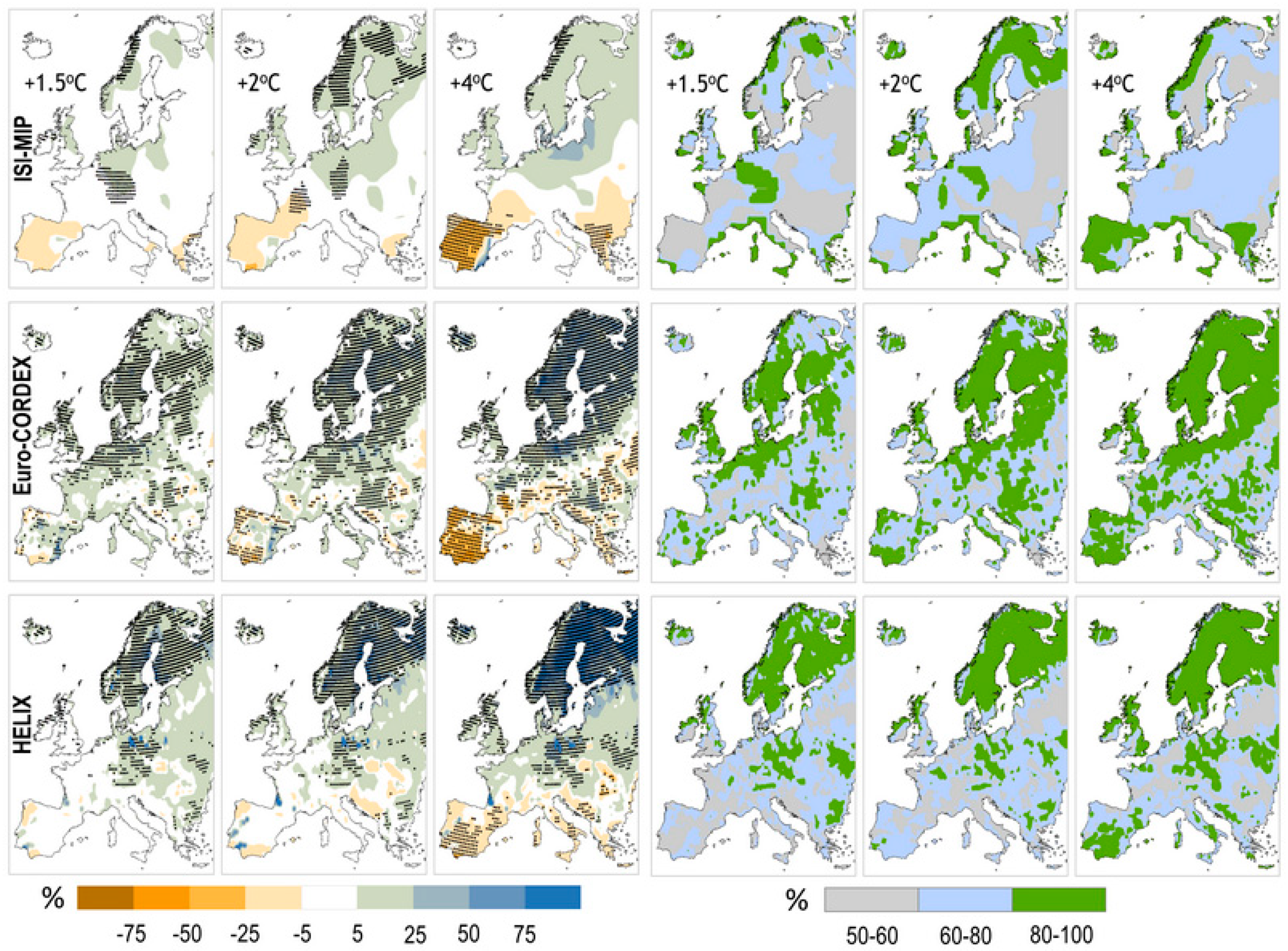
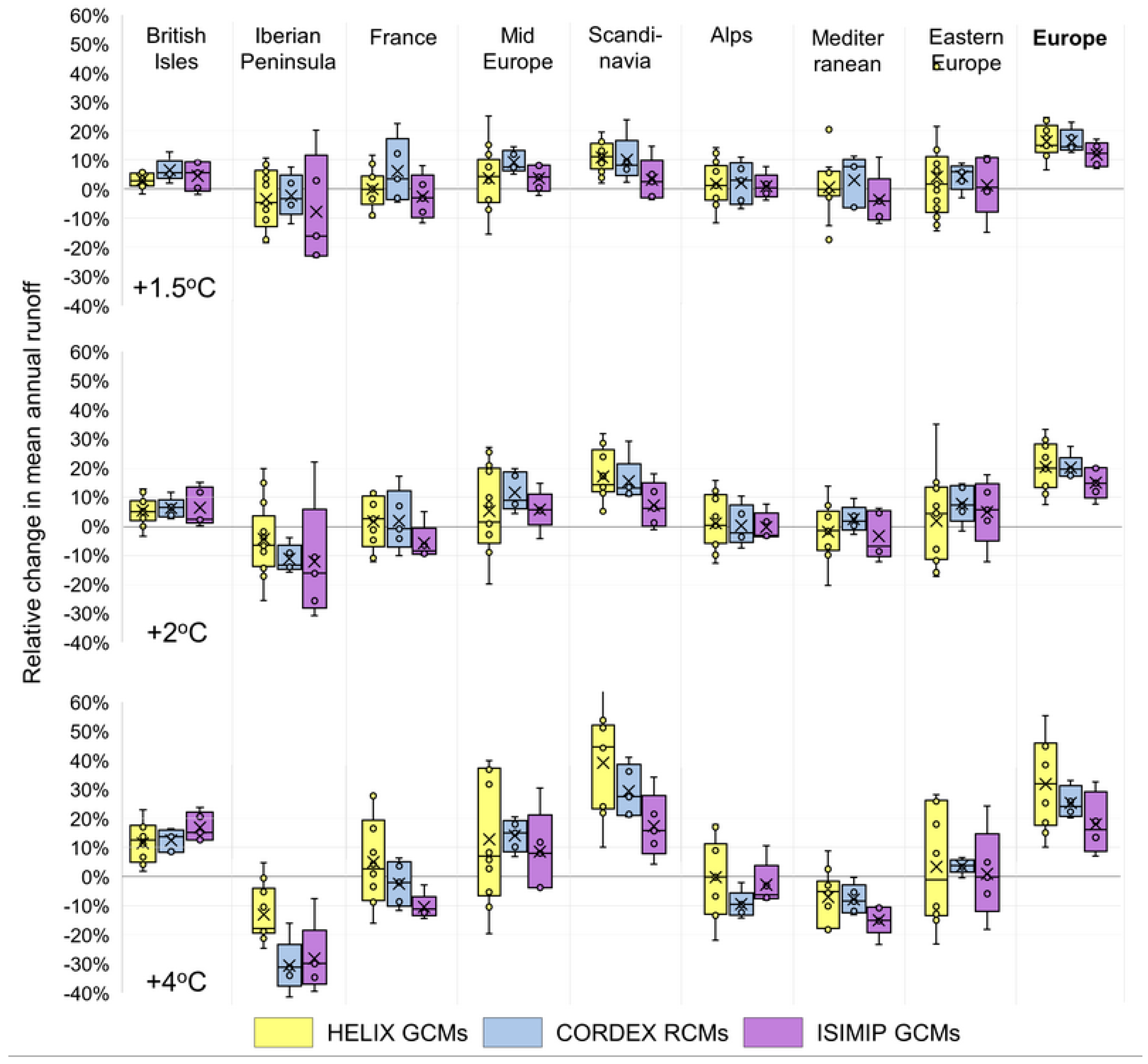
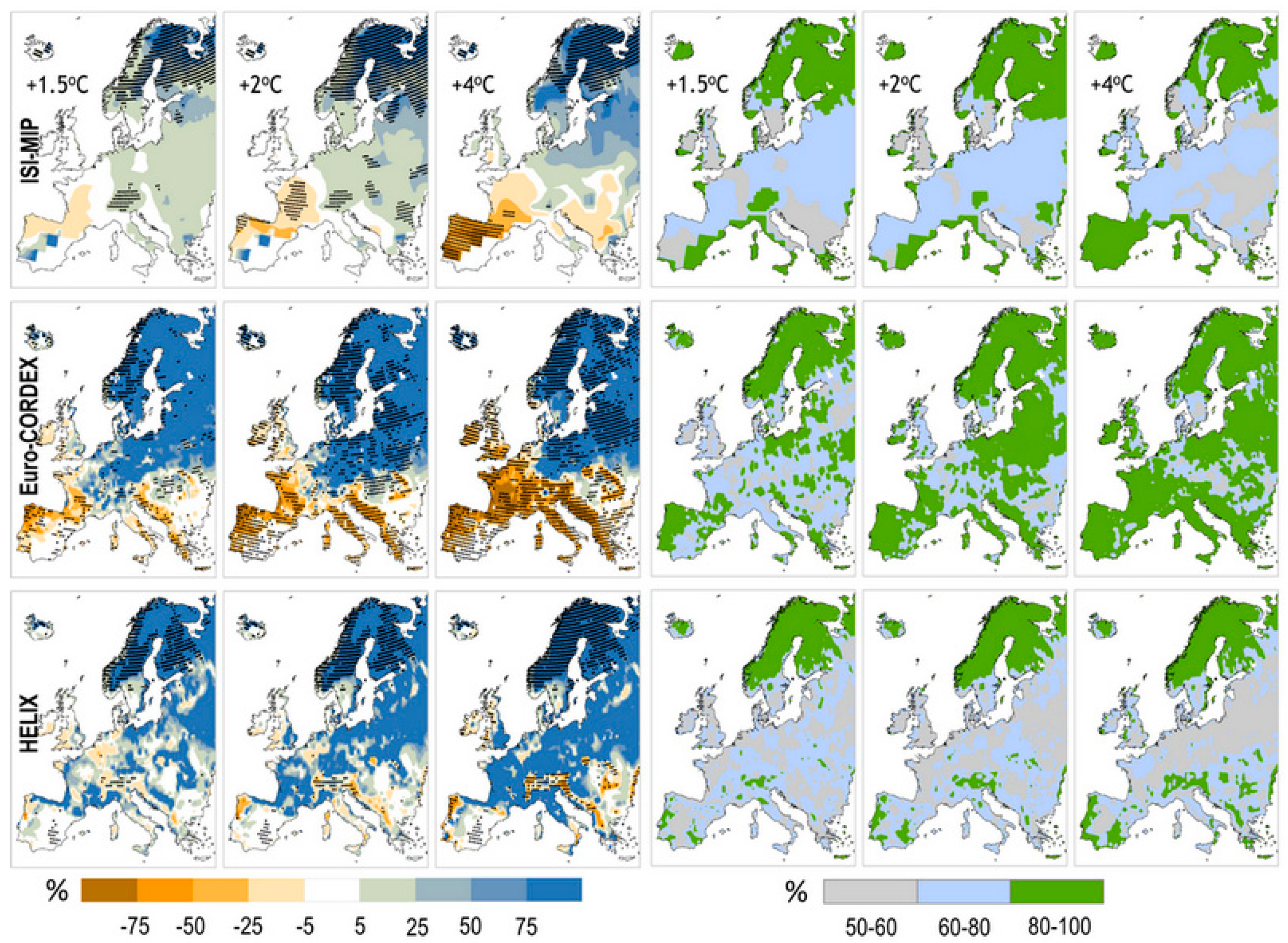
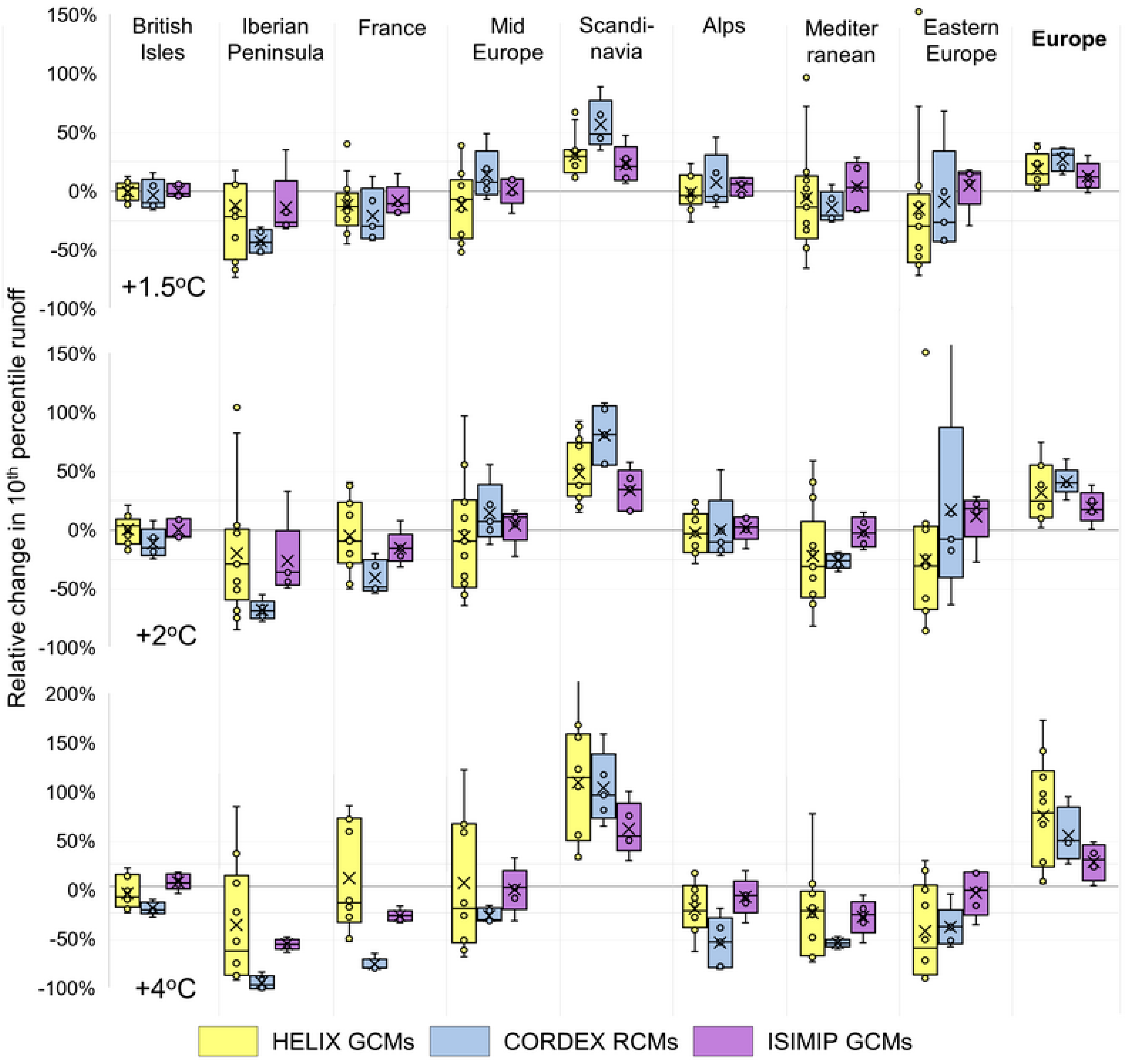
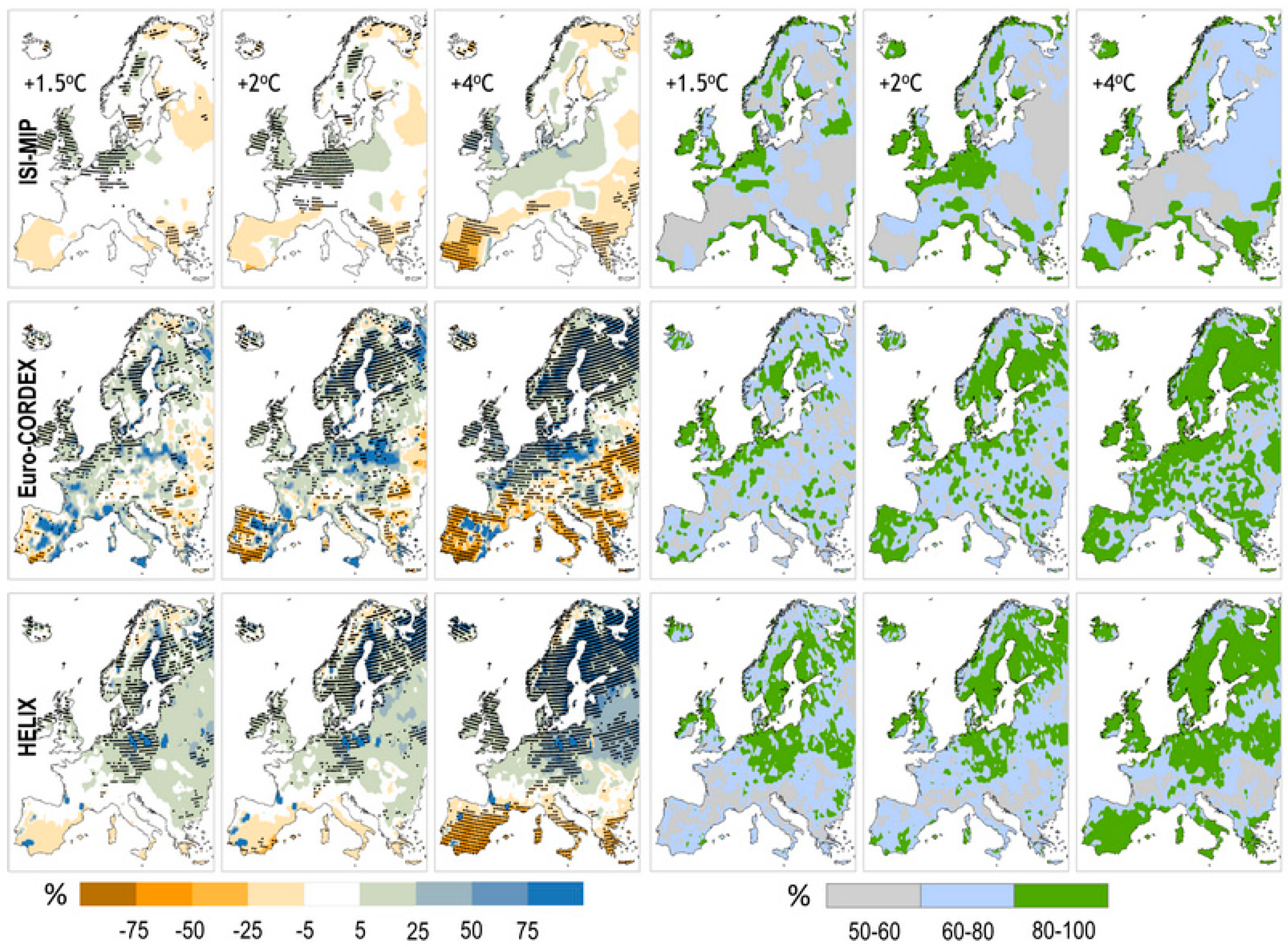
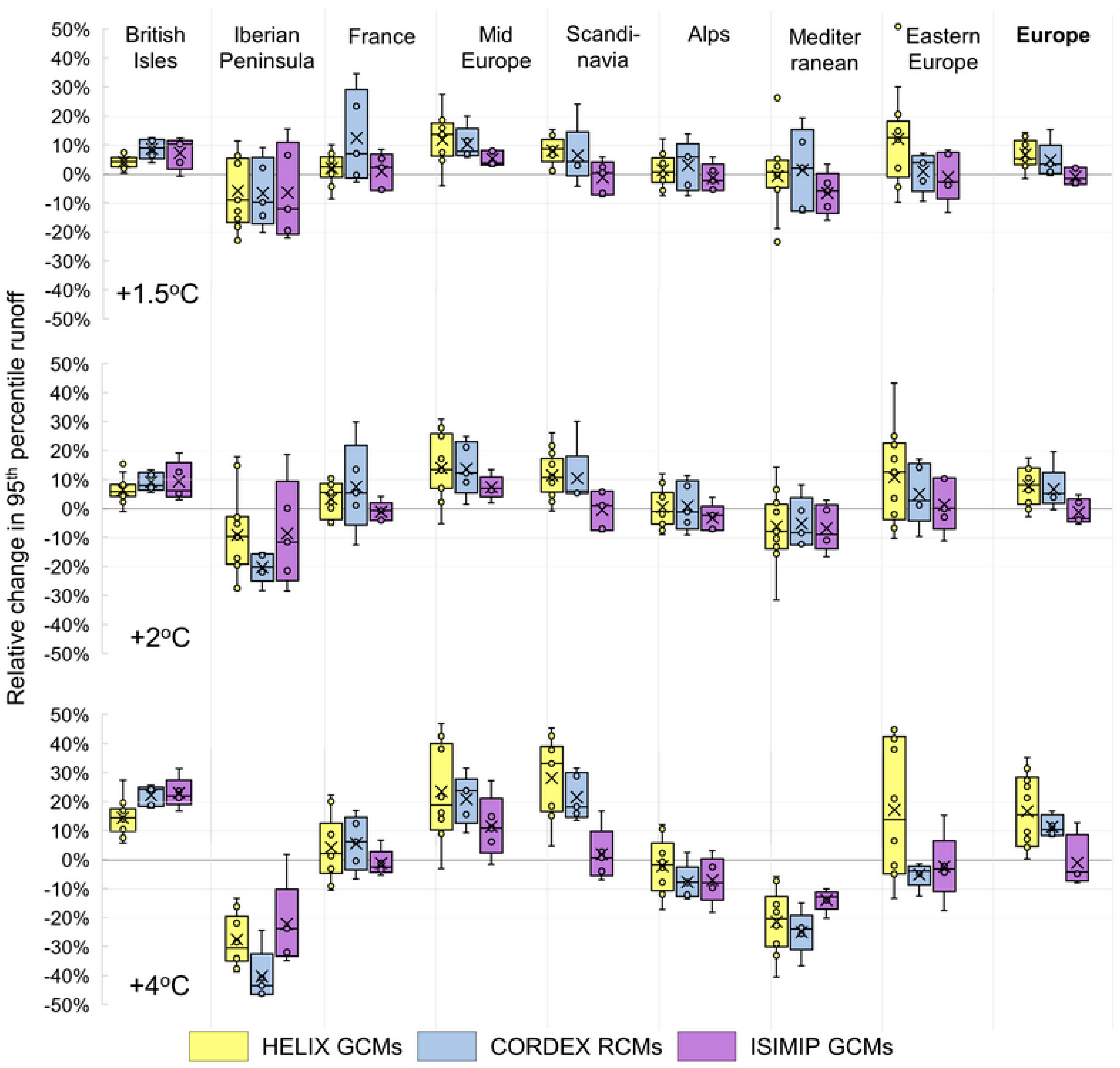
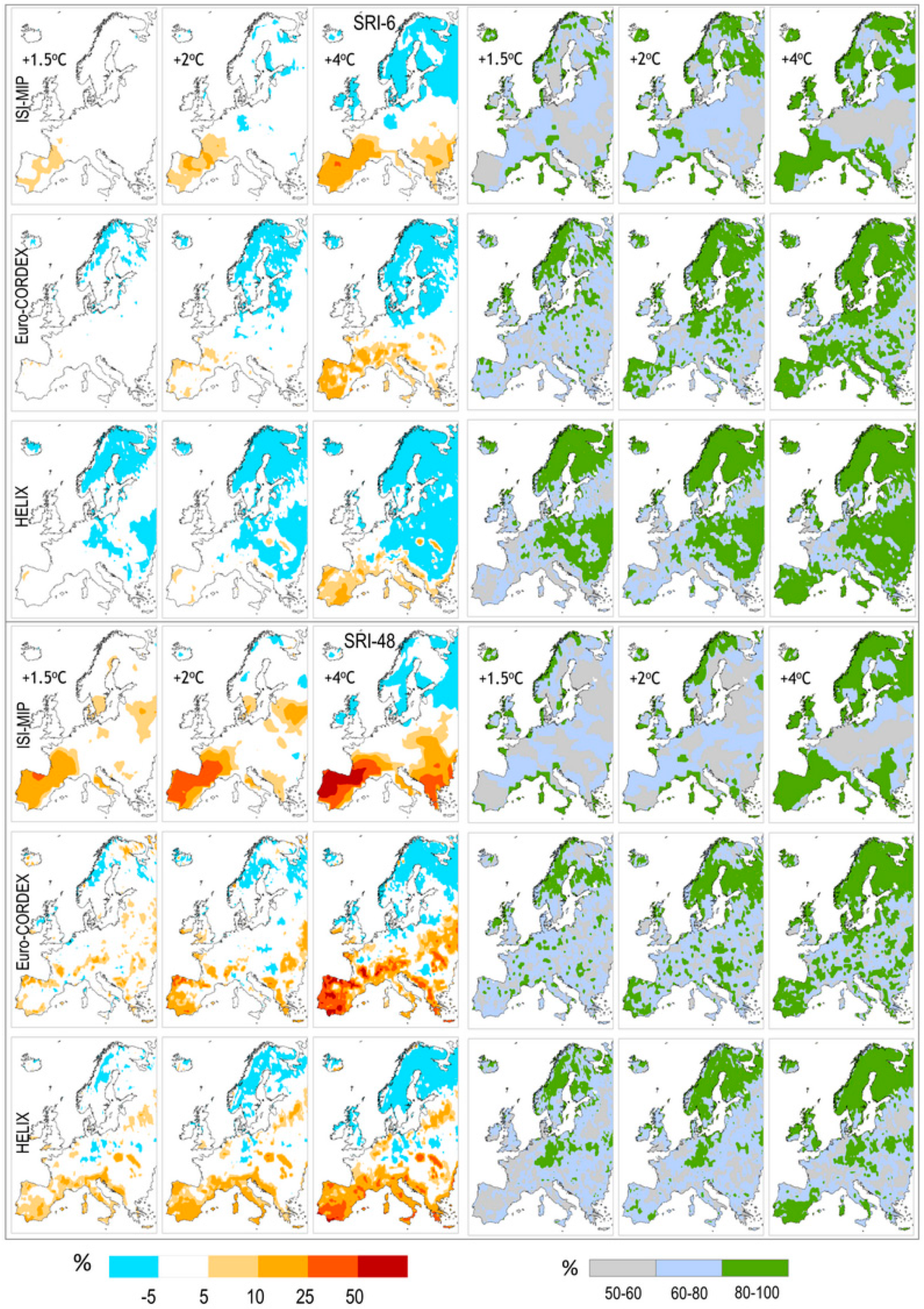
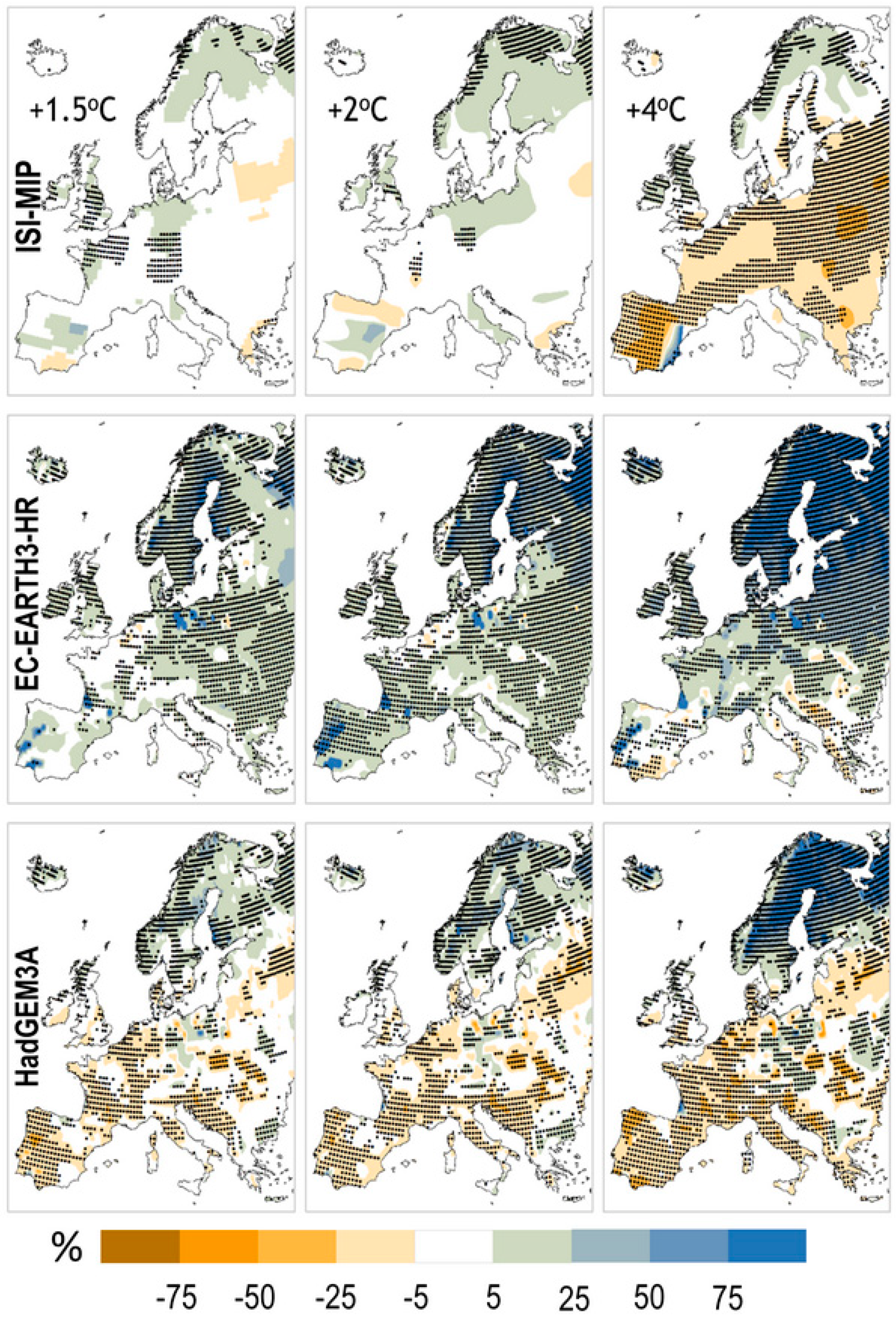
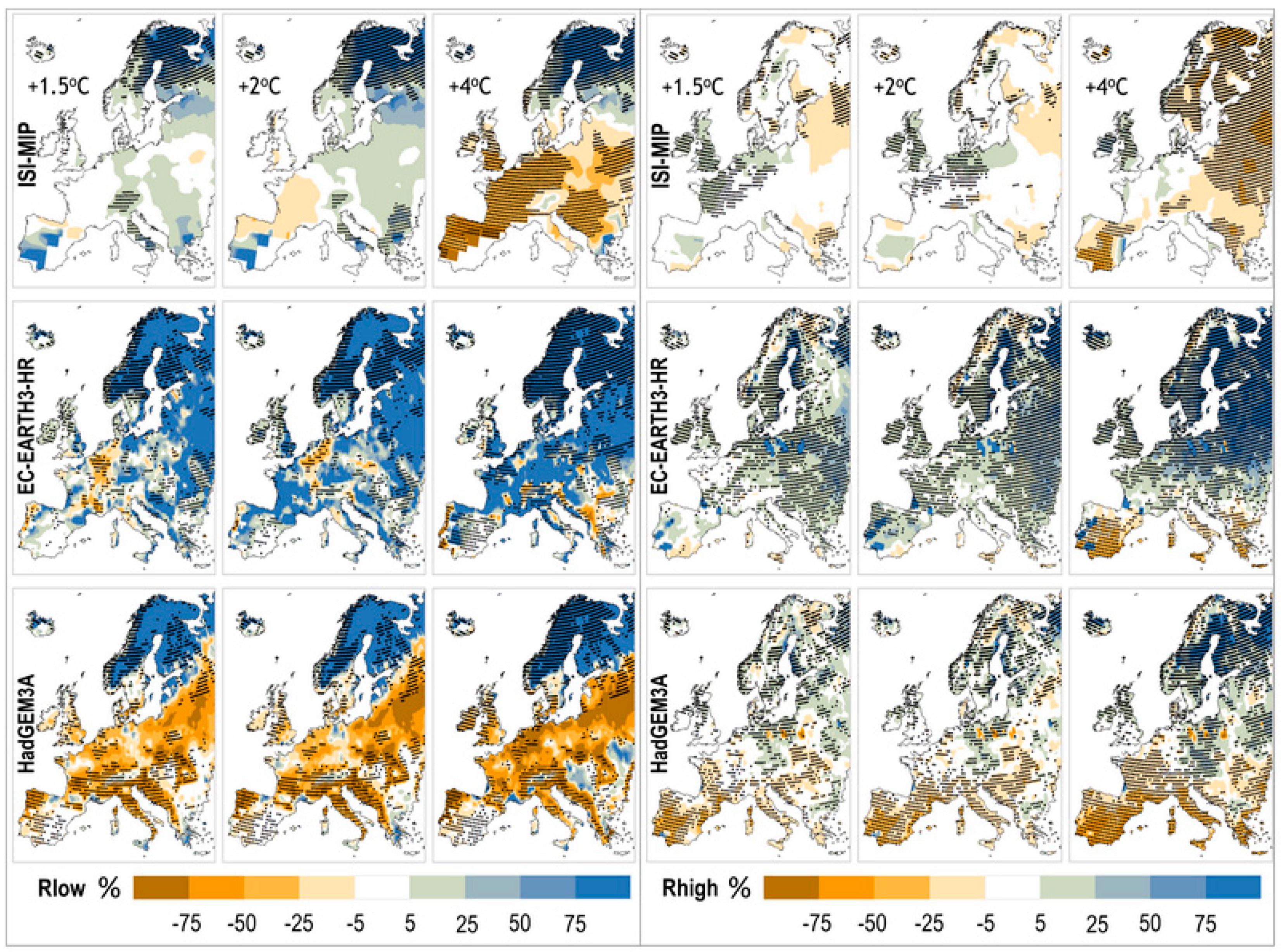
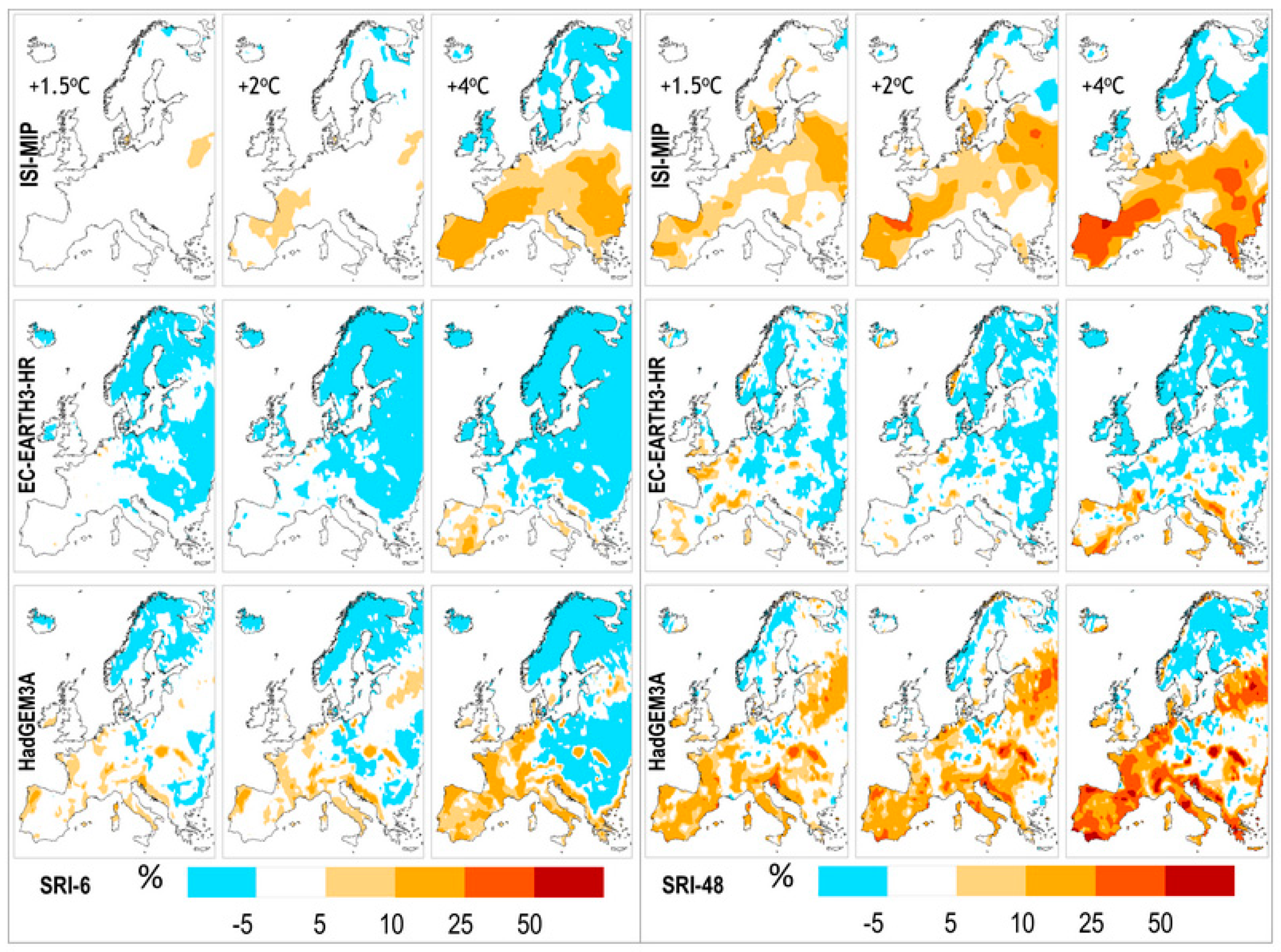
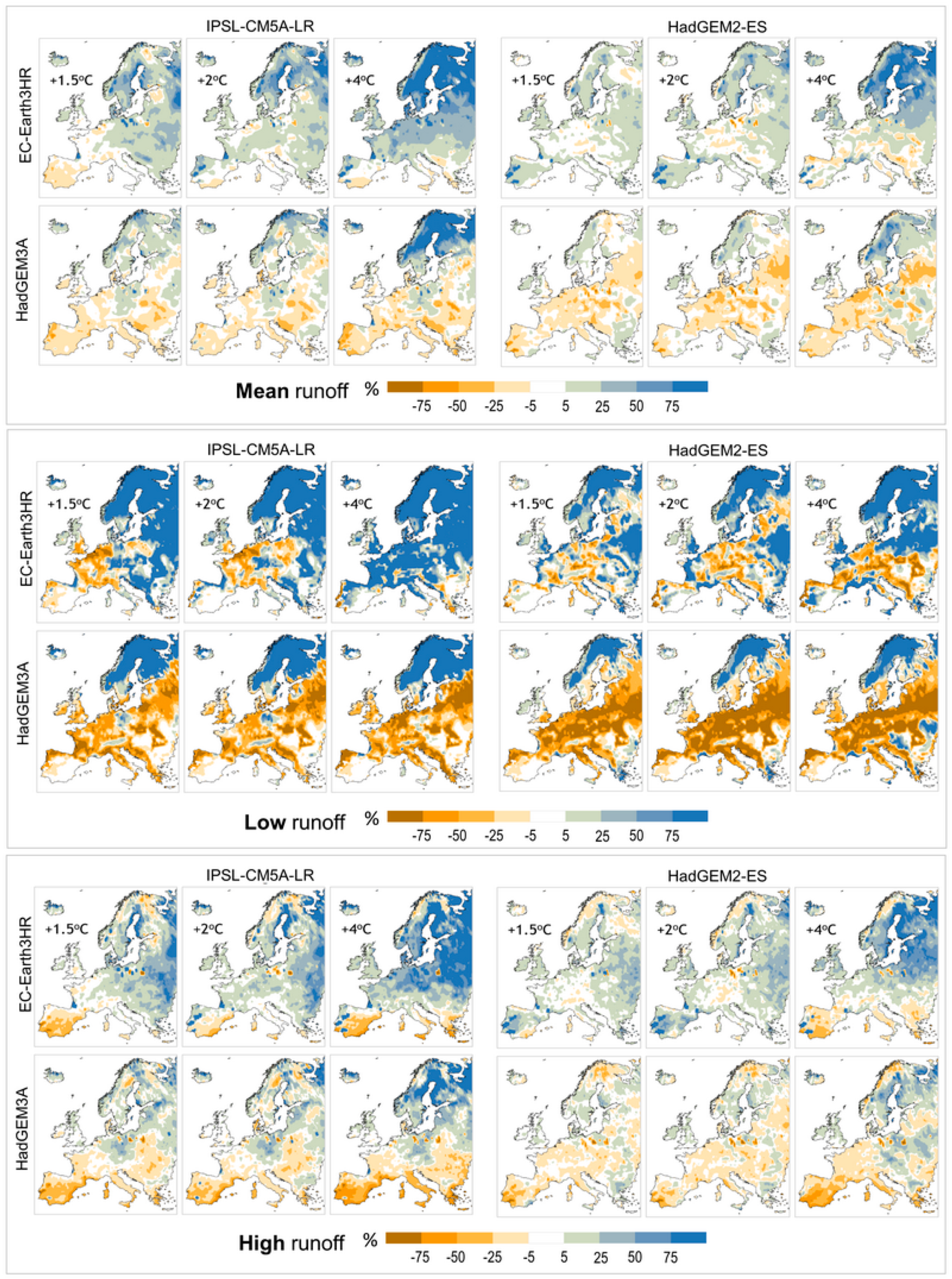
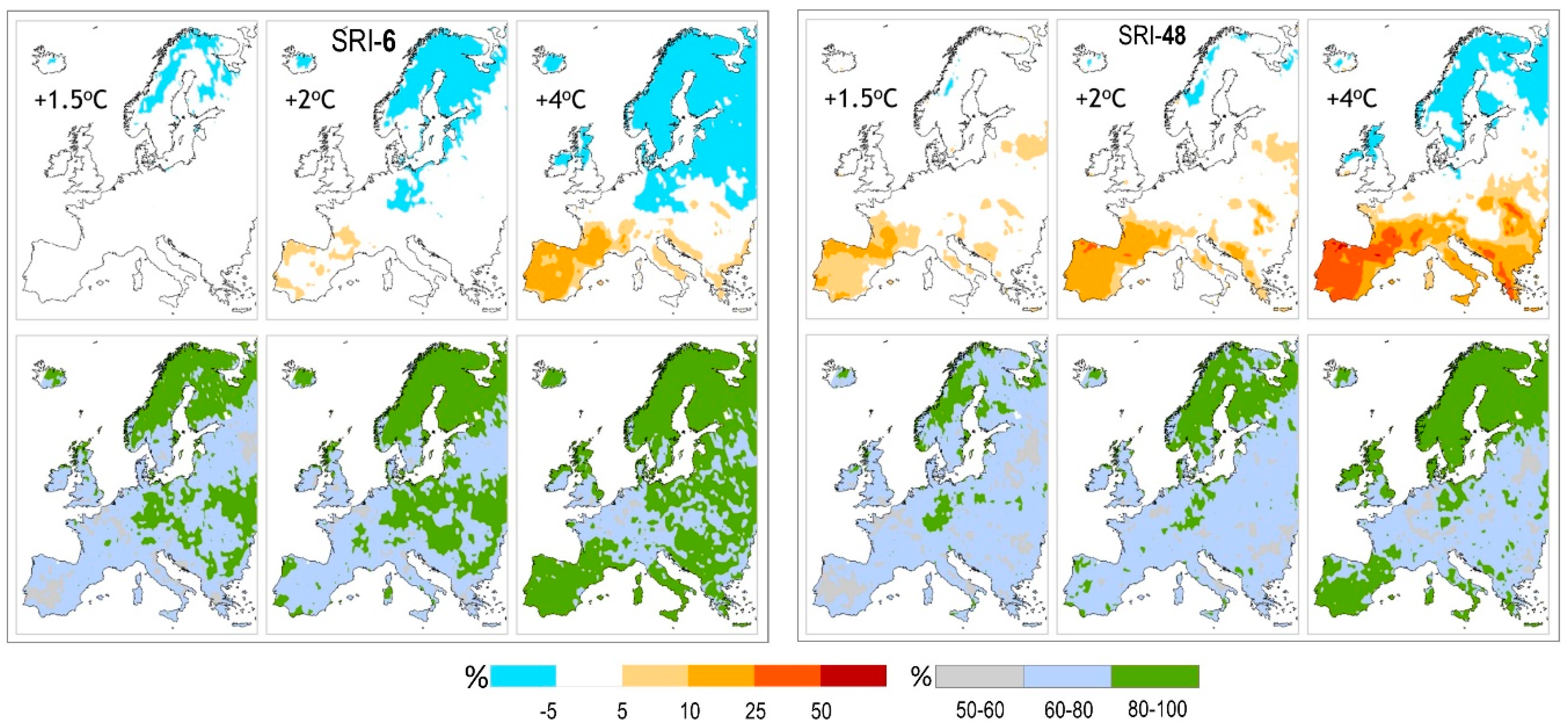
| Driving Models | ISIMIP | Euro-CORDEX | HELIX | |
|---|---|---|---|---|
| EC-EARTH3-HR | HadGEM3A | |||
| GFDL-ESM2M | X | X | X | X |
| NorESM1 | X | X | ||
| MIROC-ESM-CHEM | X | X | ||
| MIROC5 | X | |||
| IPSL-CM5A-LR | X | X | X | |
| HadGEM2-ES | X | X | X | X |
| EC-EARTH | X | |||
| GISS-E2-H | X | |||
| IPSL-CM5A-MR | X | X | X | |
| HadCM3LC | X | |||
| ACCESS1-0 | X | |||
| Driving CMIP5 Models | GWL | ISIMIP | Euro-CORDEX | HELIX | |
|---|---|---|---|---|---|
| EC-EARTH3-HR | HadGEM3A | ||||
| GFDL-ESM2M | 1.5 °C | 2040 | 2040 | 2038 | 2036 |
| 2 °C | 2055 | 2044 | 2054 | 2054 | |
| 4 °C | 3.2 * | 3.2 * | - | - | |
| NorESM1 | 1.5 °C | 2035 | 2035 | ||
| 2 °C | 2052 | 2052 | |||
| 4 °C | 3.75 * | 3.75 * | |||
| MIROC-ESM-CHEM | 1.5 °C | 2023 | 2020 | ||
| 2 °C | 2035 | 2032 | |||
| 4 °C | 2071 | 2068 | |||
| MIROC5 | 1.5 °C | 2038 | |||
| 2 °C | 2052 | ||||
| 4 °C | 3.76 * | ||||
| IPSL-CM5A-LR | 1.5 °C | 2015 | 2025 | 2024 | |
| 2 °C | 2030 | 2036 | 2035 | ||
| 4 °C | 2068 | 2074 | 2071 | ||
| HadGEM2-ES | 1.5 °C | 2027 | 2027 | 2021 | 2019 |
| 2 °C | 2039 | 2039 | 2035 | 2033 | |
| 4 °C | 2074 | 2074 | 2075 | 2071 | |
| EC-EARTH | 1.5 °C | 2028 | |||
| 2 °C | 2043 | ||||
| 4 °C | 2090 | ||||
| GISS-E2-H | 1.5 °C | 2031 | |||
| 2 °C | 2047 | ||||
| 4 °C | - | ||||
| IPSL-CM5A-MR | 1.5 °C | 2015 | 2024 | 2023 | |
| 2 °C | 2030 | 2035 | 2036 | ||
| 4 °C | 2068 | 2071 | 2069 | ||
| HadCM3LC | 1.5 °C | 2026 | |||
| 2 °C | 2040 | ||||
| 4 °C | 2088 | ||||
| ACCESS1-0 | 1.5 °C | 2026 | |||
| 2 °C | 2040 | ||||
| 4 °C | 2081 | ||||
© 2018 by the authors. Licensee MDPI, Basel, Switzerland. This article is an open access article distributed under the terms and conditions of the Creative Commons Attribution (CC BY) license (http://creativecommons.org/licenses/by/4.0/).
Share and Cite
Koutroulis, A.G.; Papadimitriou, L.V.; Grillakis, M.G.; Tsanis, I.K.; Wyser, K.; Caesar, J.; Betts, R.A. Simulating Hydrological Impacts under Climate Change: Implications from Methodological Differences of a Pan European Assessment. Water 2018, 10, 1331. https://doi.org/10.3390/w10101331
Koutroulis AG, Papadimitriou LV, Grillakis MG, Tsanis IK, Wyser K, Caesar J, Betts RA. Simulating Hydrological Impacts under Climate Change: Implications from Methodological Differences of a Pan European Assessment. Water. 2018; 10(10):1331. https://doi.org/10.3390/w10101331
Chicago/Turabian StyleKoutroulis, Aristeidis G., Lamprini V. Papadimitriou, Manolis G. Grillakis, Ioannis K. Tsanis, Klaus Wyser, John Caesar, and Richard A. Betts. 2018. "Simulating Hydrological Impacts under Climate Change: Implications from Methodological Differences of a Pan European Assessment" Water 10, no. 10: 1331. https://doi.org/10.3390/w10101331
APA StyleKoutroulis, A. G., Papadimitriou, L. V., Grillakis, M. G., Tsanis, I. K., Wyser, K., Caesar, J., & Betts, R. A. (2018). Simulating Hydrological Impacts under Climate Change: Implications from Methodological Differences of a Pan European Assessment. Water, 10(10), 1331. https://doi.org/10.3390/w10101331







